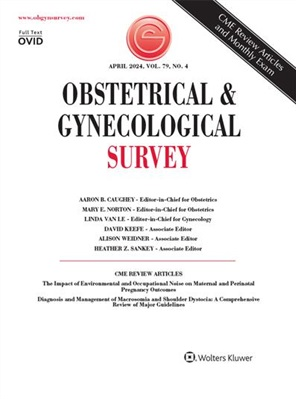Vaginal Vault Infiltration With Bupivacaine for Postoperative Pain Control After Total Laparoscopic Hysterectomy: A Randomized Control Trial
IF 3.6
4区 医学
Q1 OBSTETRICS & GYNECOLOGY
引用次数: 0
Abstract
ABSTRACT A viable alternative to total abdominal hysterectomy is total laparoscopic hysterectomy (TLH), which offers abdominal route advantages for women in need of total hysterectomy for benign diseases. Fewer complications, faster recovery, and less pain are ensured by laparoscopy, although this method is not entirely devoid of pain. Reports from various authors indicate that up to 80% of laparoscopic surgery patients require opioid analgesia, which could increase hospital-stay duration and delay mobilization/recovery. Because of these statistics, opioid analgesic usages ought to be minimized, for the aforementioned reasons and also to prevent additional adverse effects. This study was performed to evaluate efficacy of reducing postoperative pain by infiltration of bupivacaine, a long-acting anesthetic agent, into the vaginal vault after TLH. This study was a randomized control trial designed as a 2-arm double-blinded study conducted at a North-Indian Apical Center in the Department of Obstetrics and Gynecology. After written informed consent from all patients, computer-generated randomization software placed them in 1 of 2 groups: group 1, the intervention group (received the infiltration of bupivacaine in the vaginal vault following TLH), or group 2 (the control group). The inclusion criteria were a uterine size of ≤12 weeks' pregnancy and patients requiring TLH with or without bilateral salpingo-oophorectomy for uterine size and benign conditions. Exclusion criteria were contraindication to any medication used by the study, presence of malignancy, history of multiple surgeries, and history of inflammatory disease. Postoperative pain outcome measured in both groups at 1, 3, 6, 12, and 24 hours via a visual analog score was the primary outcome. The secondary outcome was the need for rescue analgesia. A complete profile of each patient was created, using eligibility criteria, body mass index, and demographic profile, and a complete gynecological and physical examination was performed, along with preoperative investigations for fitness to general anesthesia. Per standard protocol, general anesthesia was administered for all surgeries. After vault closure, a fine-tipped aspiration needle was used to administer 10 mL of bupivacaine, which was infiltrated laparoscopically at 2 different locations, approximately 2–4 cm apart. The control group omitted this step. In the first 24 hours after operation, pain was treated using 1 g intravenous paracetamol every 6 hours. For the next 5 days, patients were given nonsteroidal anti-inflammatory drugs (diclofenac) 3 times daily for 5 days. Participants scaled their pain using the visual analog scale (VAS) score at the 1, 2, 6, 12, and 24 hours intervals postsurgery. Scores greater than 4 initiated the distribution of tramadol 50 mg intramuscular. Also recorded were the uterine weight, the operative time, complications, and the amount of operative bleeding. Group 1 patients exhibited VAS scores of less than 4 at 1 hour postsurgery (100%), 3 hours postsurgery (100%), 6 hours postsurgery (97%), 12 hours postsurgery (96.7%), and 24 hours postsurgery (36.7%). The control group VAS scores of less than 4 for the respective times were as follows: 1 hour (93%), 3 hours (86.6%), 6 hours (30%), 12 hours (10%), and 24 hours (3.3%). From these data, it is clear that the infiltration with a local analgesia was effective in reducing postoperative pain. Overall, a feasible and safe option for postoperative pain relief is vaginal cuff infiltration with local anesthetic. A significant increase in the number of women experiencing minimal postoperative pain for 24 hours after laparoscopic hysterectomy took place due to infiltration of the vaginal vault with 10 mL of 0.25% bupivacaine (with no complications). Furthermore, this method reduces requirements of additional opioid/analgesia usage. The beneficial use of local vault infiltration with bupivacaine after TLH within the first 24 postoperative hours is highlighted by this study.阴道穹窿浸润布比卡因用于腹腔镜子宫全切除术后疼痛控制:一项随机对照试验
全腹腔镜子宫切除术(TLH)是一种可行的替代全腹子宫切除术的方法,它为良性疾病需要全子宫切除术的妇女提供了腹部途径的优势。腹腔镜手术并发症少,恢复快,疼痛少,尽管这种方法并非完全没有疼痛。来自不同作者的报告表明,高达80%的腹腔镜手术患者需要阿片类镇痛药,这可能会增加住院时间并延迟活动/恢复。由于这些统计数据,阿片类镇痛药的使用应该尽量减少,出于上述原因,也为了防止额外的不良反应。本研究旨在评估布比卡因(一种长效麻醉剂)在TLH后阴道穹窿内浸润减轻术后疼痛的效果。本研究是一项随机对照试验,设计为两组双盲研究,在北印度妇产科顶点中心进行。在获得所有患者的书面知情同意后,计算机生成的随机化软件将他们分为两组:1组,干预组(TLH后阴道穹窿浸润布比卡因)或2组(对照组)。纳入标准为:子宫大小≤12周,子宫大小及良性情况需要行双侧输卵管卵巢切除术的TLH患者。排除标准为研究中使用的任何药物禁忌症、存在恶性肿瘤、多次手术史和炎症性疾病史。术后1、3、6、12和24小时通过视觉模拟评分测量两组的疼痛结局是主要结局。次要结果为是否需要抢救性镇痛。使用资格标准、体重指数和人口统计资料,对每位患者进行了完整的概况,并进行了完整的妇科和体格检查,以及术前对全身麻醉的适应性调查。按照标准方案,所有手术均采用全身麻醉。闭合穹窿后,使用细尖抽吸针给药10ml布比卡因,在腹腔镜下浸润2个不同的位置,间隔约2 - 4 cm。对照组省略了这一步。术后24小时内,每6小时静脉注射扑热息痛1 g。在接下来的5天,患者给予非甾体抗炎药(双氯芬酸),每天3次,连续5天。参与者在术后1、2、6、12和24小时间隔使用视觉模拟量表(VAS)对疼痛进行评分。评分大于4分开始曲马多50mg肌内注射。同时记录子宫重量、手术时间、并发症及术中出血量。组1患者术后1小时(100%)、3小时(100%)、6小时(97%)、12小时(96.7%)、24小时(36.7%)VAS评分均小于4分。对照组VAS评分低于4分的分别为:1小时(93%)、3小时(86.6%)、6小时(30%)、12小时(10%)、24小时(3.3%)。从这些数据可以清楚地看出,局部镇痛的浸润在减轻术后疼痛方面是有效的。总的来说,局部麻醉阴道袖口浸润是一种可行且安全的术后疼痛缓解方法。由于10ml 0.25%布比卡因浸润阴道穹窿(无并发症),腹腔镜子宫切除术后24小时内出现轻微术后疼痛的妇女人数显著增加。此外,这种方法减少了额外使用阿片类药物/镇痛药的需求。本研究强调了TLH术后24小时内布比卡因局部拱顶浸润的有益应用。
本文章由计算机程序翻译,如有差异,请以英文原文为准。
求助全文
约1分钟内获得全文
求助全文
来源期刊
CiteScore
2.70
自引率
3.20%
发文量
245
审稿时长
>12 weeks
期刊介绍:
Each monthly issue of Obstetrical & Gynecological Survey presents summaries of the most timely and clinically relevant research being published worldwide. These concise, easy-to-read summaries provide expert insight into how to apply the latest research to patient care. The accompanying editorial commentary puts the studies into perspective and supplies authoritative guidance. The result is a valuable, time-saving resource for busy clinicians.

 求助内容:
求助内容: 应助结果提醒方式:
应助结果提醒方式:


